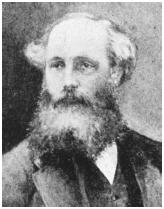James Clerk Maxwell
SCOTTISH PHYSICIST
1831–1879
James Clerk Maxwell is generally regarded as one of the outstanding physicists of the nineteenth century. He made important advances in the theory of electricity and magnetism, as well as in thermodynamics and the kinetic theory of gases. Many modern ideas about these topics are still based on his work from the mid-1800s.

Maxwell was born in Edinburgh, Scotland, and his father greatly encouraged him in his intellectual pursuits. At the age of fourteen, while a student at the Edinburgh Academy, he wrote a paper on ovals and geometric figures with more than two foci. His paper was read to the Royal Society of Edinburgh by an adult member because it was considered inappropriate for a young boy to present it to the society himself. Although some of the ideas in this paper had been discussed earlier by the renowned French mathematician René Descartes, it was still an amazing achievement for a teenage boy.
At sixteen, Maxwell entered Edinburgh University, where he studied physics, mathematics, and logic. Three years later he went to Cambridge University, from which he graduated in 1854 with a degree in mathematics.
In 1856 Maxwell became professor of natural philosophy at Marischal College in Aberdeen. There he became interested in the theory of gases and in the study of electricity and magnetism. His position as professor, however, was eliminated in 1860 when Marischal and another college merged.
Maxwell spent the next five years at King's College in London. He successfully applied statistical methods to describe the movements of the tiny invisible particles of a gas, an approach adopted a century earlier by the Swiss mathematician Daniel Bernoulli, but with less sophisticated mathematics. The Austrian physicist Ludwig Boltzmann also studied the problem of gas behavior at the same time as Maxwell, and the names of both men are usually associated with the kinetic theory of gases.
Because of his overwhelming interest in the science of electricity, Maxwell was drawn to the writings of the English physicist Michael Faraday, who had begun publishing his three-volume Experimental Researches in Electricity in 1839. Faraday's approach was almost entirely experimental, and Maxwell saw this as an opportunity to treat the subject in mathematical terms. Beginning in the 1850s, Maxwell published several papers on electricity, including the analogy between electricity and heat from a mathematical point of view. These research efforts culminated in his important writings in the 1860s and 1870s on electromagnetic theory and his identification of light as an electromagnetic wave. Maxwell's theoretical conclusions about electro-magnetism are summarized in a set of four equations known as Maxwell's equations, which first appeared in his Treatise on Electricity and Magnetism in 1873 and were later cast in their modern form by other physicists.
In 1865 Maxwell resigned his position in London and returned to his family estate Glenair in Scotland, where he continued his scientific work for five years. In 1870, however, a new chair and laboratory of physics were established at Cambridge University, and Maxwell eventually accepted an offer after two other physicists had refused. Maxwell continued his work in electricity and magnetism, organized the new laboratory, and edited the papers of Henry Cavendish for whom the laboratory was named. Early in 1879 Maxwell's health began to decline, and he died several months later during his forty-ninth year.
SEE ALSO Boltzmann, Ludwig ; Cavendish, Henry ; Faraday, Michael ; Magnetism ; Physical Chemistry .
Richard E. Rice
Bibliography
Cropper, William H. (2001). "The Scientist as Magician: James Clerk Maxwell." In Great Physicists: The Life and Times of Leading Physicists from Galileo to Hawking. New York: Oxford University Press.
Internet Resources
Haley, Christopher. "James Clerk Maxwell (1831–1879) Mathematical Physicist." Available from http://65.107.211.206/science/maxwell1.html .
O'Connor, J. J., and Robertson, E. F. "James Clerk Maxwell." Available from http://www-gap.dcs.st-and.ac.uk/~history/Mathematicians/Maxwell.html .
O'Connor, J. J., and Robertson, E. F. "A Visit to James Clerk Maxwell's House." Available from http://www-gap.dcs.st-and.ac.uk/~history/HistTopics/Maxwell_House.html .
Comment about this article, ask questions, or add new information about this topic: